
The index page for the 1954 French flap section of this website is here.
During the wave of flying "saucers" and flying "cigars" in France in 1954, the press alluded to or described a British flying apparatus whom the press referred to as the "Lit-cage volant" ("Flying Cage-Bed").
This page explains what this was all about.
Most newspapers explained it correctly, for example via this Press release and photo from Agence France Presse:
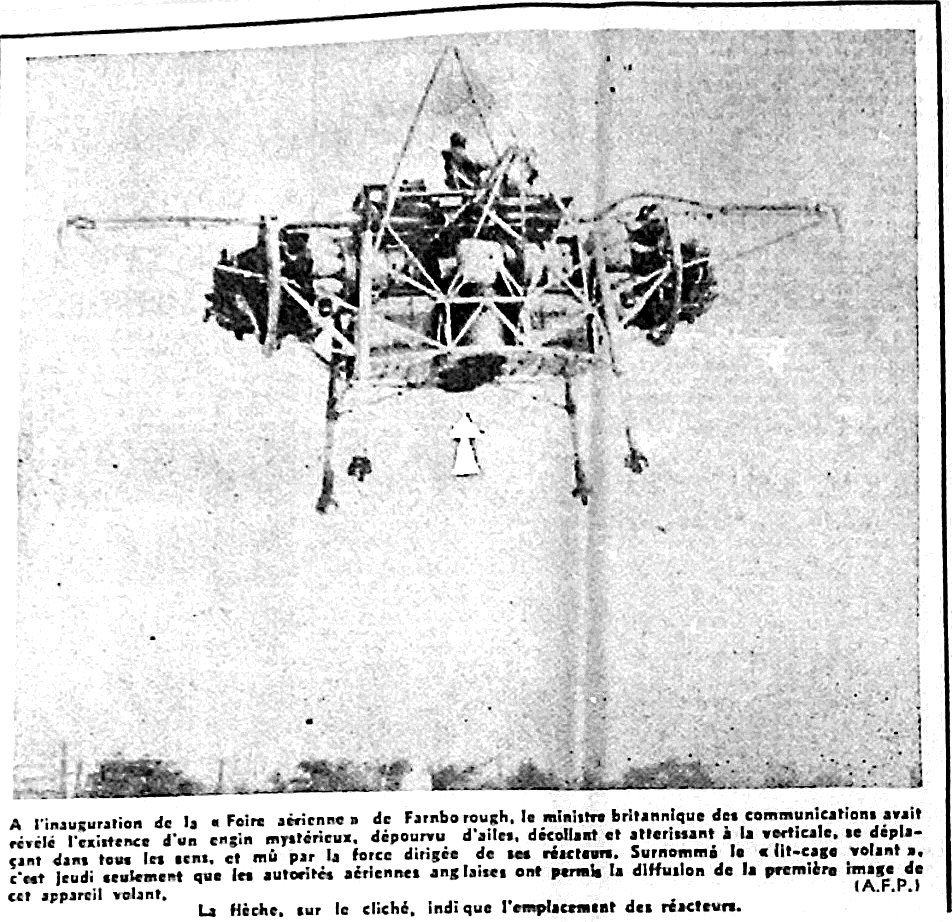
|
At the inauguration of the Farnborough Air Show, the British Minister for Communications revealed the existence of a mysterious craft, without wings, taking off and landing vertically, moving in all directions, and moved by the directed force of its jet engines. Nicknamed the "flying cage-bed", it was only Thursday that the British air authorities allowed the broadcast of the first image of this flying craft.
(A.F.P.)
The arrow on the photo indicates the location of the jet engines.
The first information on the "Flying cage-bed" in the French press came out on September 9, 1954 (for example La Croix, page 6), the day before the "initial" cases of Quarouble and Mouriéras according to their witnesses, which can be thoughtful, even suggest an inspiration!
This is an attractive idea at first glance, but it could not be so simple: in the case of Quarouble, the witness, whether he was lying or telling the truth, does not describe human pilots and the "craft" does not resemble the "flying bed-cage"; in the case of Mouriéras, the witness did describe a human pilot indeed - the craft is hardly described - but why would he not then have used the publicity around the "Flying cage bed" as "corroboration" of his claims, if he had known about it?
Some press sources had fantasized a lot about the craft in September 1954, presenting very little resembling sketches. Thus in Paris-Presse for September 9, 1954, on page 10:
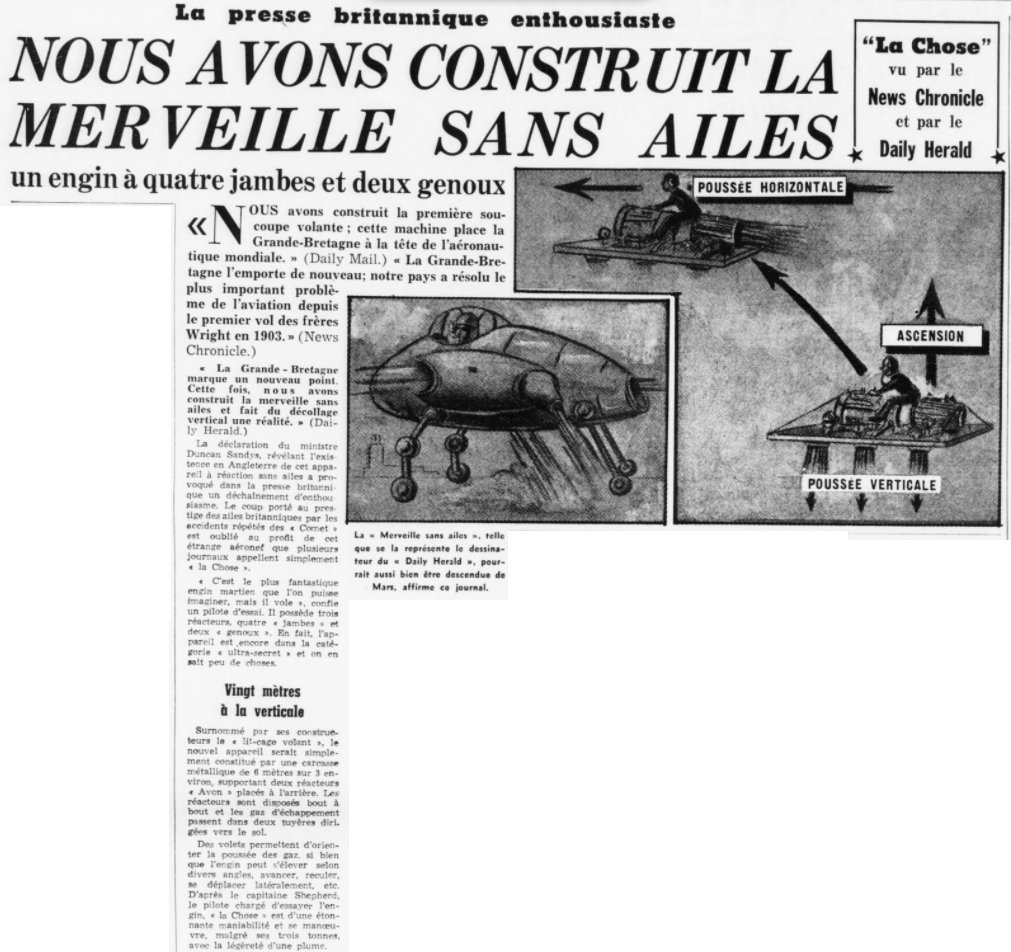
|
"We built the first flying saucer; this machine places Britain at the head of world aeronautics." (Daily Mail). "Britain wins again; our country has solved the most important aviation problem since the Wright brothers' first flight in 1903". (News Chronicle.)
"Britain marks a new hit. This time we built the wingless wonder and made vertical takeoff a reality." (Daily Herald).
Minister Duncan Sandys' statement revealing the existence in England of this wingless jet aircraft has sparked enthusiasm in the British press. The blow to the prestige of the British wings by the repeated accidents of the "Comets" is forgotten in favor of this strange aircraft that several newspapers simply call "the Thing".
"This is the most fantastic Martian machine you can imagine, but it flies," said a test pilot. It has three reactors, four legs and two knees. In fact the device is still in the "top secret" category and little is known about it.
Nicknamed by its manufacturers the "flying bed cage", the new device would simply consist of a metallic frame measuring approximately 6 by 3 meters, supporting two "Avon" jet engines placed at the rear. The jet engins are end to end and the exhaust gases pass through two nozzles directed towards the ground.
Flaps make it possible to direct the thrust of the gas, so that the craft can rise at various angles, move forward, backward, move sideways, etc. According to Captain Shepperd, the pilot in charge of testing the machine, "the Thing" is surprisingly manoeuvrable and can be handled, despite its three tons, with the lightness of a feather.
For almost a year now, Rolls-Royce engineers have been testing this device on the Hucknall site. [...]
[Image caption]: The "Wingless Wonder", as the Daily Herald designer imagines it, might as well have descended from Mars, the newspaper claims.
The sketches, whimsical because the craft had not yet been shown, came from the British press, here is the one published by the newspaper La Bourgogne Républicaine:
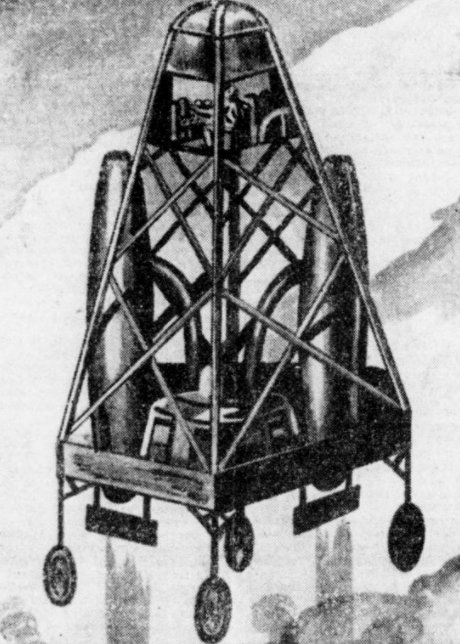
|
I found the first authentic pictures of the craft in Paris-Presse for September 25, 1954 on page 1.
Some press sources, some magazines, quickly cooled down the fantasies that the thing could arouse:
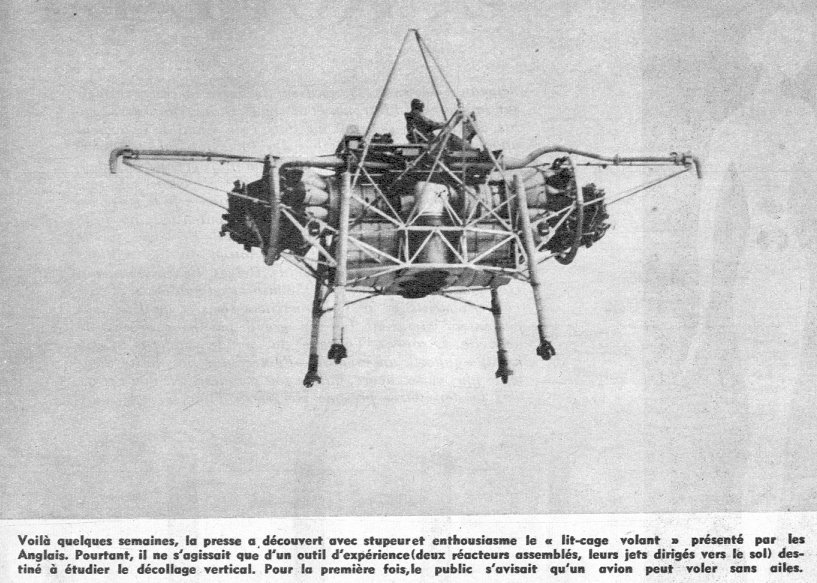
|
A few weeks ago, the press discovered with amazement and enthusiasm the "flying bed-cage" presented by the English. However, it was only a good experimental tool (two reactors assembled, their jets directed towards the ground) intended to study the vertical takeoff. For the first time, the public realized that an airplane can fly without wings.
However, in some newspapers, the connection with the "flying saucers" was put forth, as for example in Le Progrès du Nord for October 1, 1954:
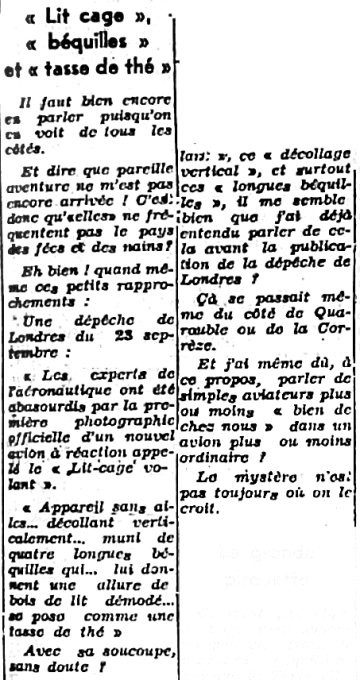
|
We still have to talk about it since we see it on all sides.
And to think that such an adventure has not yet happened to me! So it is that they do not frequent the land of fairies and dwarves?
Well! all the same these small reconciliations:
A dispatch from London on September 23:
"Aviation experts were stunned by the first official photograph of a new jet called the 'Flying Bed Cage'.
"Aircraft without wings... taking off vertically... fitted with four long crutches... giving it the look of old-fashioned wood bed... sits like a cup of tea"
With its saucer, no doubt?
[...], this vertical takeoff, and especially these "long crutches", it seems to me that I already heard about that before the publication of the London dispatch?
It even happened in Quarouble or in the Corrèze.
And I even had, in this regard, spoken of simple aviators more or less "from down here" in a more or less ordinary plane!
The mystery is not always where you think it is.
We note that the author of the post believes he has found the solution to at least two "famous" cases in France in the fall of 1954.
The "bed-cage" does not correspond in any way to the descriptions of the alleged "craft" of these two cases; but it must be admitted that in the context of the time, there was nothing shameful in making this "reconciliation". With hindsight and by consulting my catalog, it can be seen that simple, very ordinary helicopters were sufficient to explain many cases. It appears that several "famous" cases of allegedly "extraterrestrial" landings for many ufologists clearly involved very human "occupants." As in the whole of the history of ufology, misinterpretations can be caused by very human aircraft, without the need to call upon "secret aircraft"; which are almost never at the origin of such misinterpretations, for very simple reasons:
No ufologist, to my knowledge, has ever suggested that the "Flying bed-cage" would explain even a single case of the 1954 wave in France.
The reality regarding the "Flying bed-cage " is as follows:
The "Lit-Cage volant" existed; it was the French nicname of the nicknamed "Flying Bedstead", the official name being "the Rolls-Royce Thrust-Measuring Rig (TMR)."
It was an experimental aircraft that was first flown on August 2, 1954, to test the VTOL (vertical takeoff-and-landing) concept.
It was the first jet powered VTOL aircraft. It was fitted with two Rolls-Royce MK4 Nene jet engines, which were standard engines modified only by an air bleed system that allowed 10% of the engine compressor air to bleed off for the control systems of the rig.
It was supported by four hydraulic oleo legs. A platform across the structure above the engines had a seat bolted to it together with a conventional type control column and pedals that operated control valves from the engine compressor air bleed system collector box. The craft was controlled by bleeding air from the engine through the control valves to diametrically opposed pipes, each equipped with a nozzle that could swivel 30° in either direction for turning the rig left or right. The control valves were also interconnected to the control column so that movement of the column would restrict the flow of air to the nozzles, thereby reducing the thrust and tus controlling which direction the rig would go.
The thrust-to-weight ratio of the rig was critical: any vertical take off (VTO) aircraft must have a engine thrust that's greater than the total weight. The latter was minimized so as to keep within a 25% thrust advantage. Each engine provided a thrust of 3,850 lb, which, added to the 325-lb thrust from each of the bleed nozzles, gave a total available thrust of 8,350 lb. This compared with a total weight for the rig, complete with pilot and full fuel tanks, of 7,196 lb. Handling improved as fuel was consumed; total running time was about 15 min.
The first prototype, called XA314, made an initial ground run on July 3, 1953, before first attempting to lift off the ground on July 6, 1953, piloted by wing-commander Harvey Hayworth, Rolls Royce chief test pilot. The rig lifted only to the full extent of the hydraulic oleo legs so that the wheels did not actually leave the ground.
With cables attached to either side and above the rig, it was tested again on November 19, 1953, for extensive modifications and overhaul inspection of the engines. Most of the tests were donne at the Hucknall Rolls Royce plant.
After several months in the workshops, the craft made a tethered flight in Derby, carried out to test the modifications. These were so successful that preparations were made for the first free flight; which took place on Aug 3, 1954, and was piloted by Capt. Ron Shepherd before a distinguished audience. The rig rose slowly into the air and was held steady in a hover attitude. It then moved forward, made a circuit of the test area was made, and demonstrated sideways and backwards movements before successfully landing. During the next four months a number of free flights were made, all at a height of 13-15 feet but one flight was made up to 50 feet to ensure that there was no ground effect influencing the rig. The final flight took place on December 15, 1954.
Then it was tranferred from Derby to Farnborough, where it was flown and shown to the Press. It appears it was also shown an Air Display at Gatwick Airfield in 1954.
It never flew in France.
A second rig was built but crashed on November 28, 1957, near Nottingham, killing the pilot, and testing subsequently ceased.
However, the VTOL concept became succesful later, when the P.1127 "Harrier", tested in 1960, was built by Hawker Siddeley and about 800 of them were put in use in the Royal Air Force, the Royal Navy, and other countries:
The Harrier, however, used a quite different lift system.
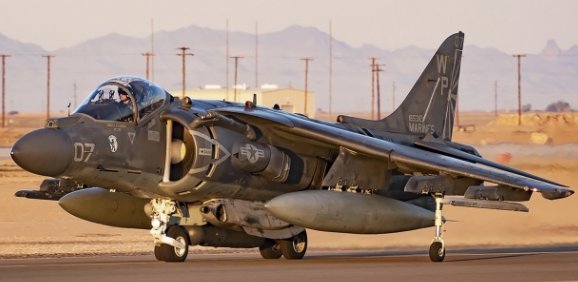
|
A good, detailed, source about the "Rolls-Royce Thrust-Measuring Rig" is at http://naca.central.cranfield.ac.uk/reports/arc/rm/3336.pdf
Of course, France also had projects of VTOL aircraft: but this is a different story, and it is also not the solution to any case of the 1954 French flap.
| Version: | Created/Changed by: | Date: | Change Description: |
|---|---|---|---|
| 1.0 | Patrick Gross | February 15, 2021 | First published. |